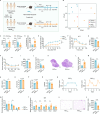Gut Microbiota Modulation by Inulin Improves Metabolism and Ovarian Function in Polycystic Ovary Syndrome
- PMID: 40192074
- PMCID: PMC12120758
- DOI: 10.1002/advs.202412558
Gut Microbiota Modulation by Inulin Improves Metabolism and Ovarian Function in Polycystic Ovary Syndrome
Abstract
The management of metabolic disorder associated with polycystic ovary syndrome (PCOS) has been suggested as an effective approach to improve PCOS which is highly involved with gut microbiota, while the underlying mechanism is unclear. Here, we investigated the role of inulin, a gut microbiota regulator, in the alleviation of PCOS. Our findings showed that inulin treatment significantly improved hyperandrogenism and glucolipid metabolism in both PCOS cohort and mice. Consistent with the cohort, inulin increased the abundance of microbial co-abundance group (CAG) 12 in PCOS mice, including Bifidobacterium species and other short-chain fatty acids (SCFAs)-producers. We further verified the enhancement of SCFAs biosynthesis capacity and fecal SCFAs content by inulin. Moreover, inulin decreased lipopolysaccharide-binding protein (LBP) and ameliorated ovarian inflammation in PCOS mice, whereas intraperitoneal lipopolysaccharide (LPS) administration reversed the protective effects of inulin. Furthermore, fecal microbiota transplantation (FMT) from inulin-treated patients with PCOS enhanced insulin sensitivity, improved lipid accumulation and thermogenesis, reduced hyperandrogenism and ovarian inflammatory response in antibiotic-treated mice. Collectively, these findings revealed that gut microbiota mediates the beneficial effects of inulin on metabolic disorder and ovarian dysfunction in PCOS. Therefore, modulating gut microbiota represents a promising therapeutic strategy for PCOS.
Keywords: fecal microbiota transplantation; gut microbiota; inulin; polycystic ovary syndrome; short‐chain fatty acids.
© 2025 The Author(s). Advanced Science published by Wiley‐VCH GmbH.
Conflict of interest statement
The authors declare no competing interests.
Figures







References
-
- Joham A. E., Norman R. J., Stener‐Victorin E., Legro R. S., Franks S., Moran L. J., Boyle J., Teede H. J., Lancet Diabetes Endocrinol. 2022, 10, 668. - PubMed
-
- Escobar‐Morreale H. F., Nat. Rev. Endocrinol. 2018, 14, 270. - PubMed
-
- Walter K., JAMA, J. Am. Med. Assoc. 2022, 327, 294. - PubMed
-
- Stener‐Victorin E., Teede H., Norman R. J., Legro R., Goodarzi M. O., Dokras A., Laven J., Hoeger K., Piltonen T. T., Nat. Rev. Dis. Primers 2024, 10. - PubMed
-
- Anagnostis P., Tarlatzis B. C., Kauffman R. P., Metabolism 2018, 86, 33. - PubMed
MeSH terms
Substances
Grants and funding
- 23Y11909600/Science and Technology Commission of Shanghai Municipality
- 1365/Talent reservoir program of Shanghai First Maternity and Infant Hospital
- 81871213/National Natural Science Foundation of China
- 81671468/National Natural Science Foundation of China
- SHDC2020CR4080/Shanghai Municipal Hospital Development Center
LinkOut - more resources
Full Text Sources
Medical
Miscellaneous
